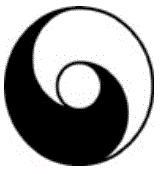Tai Ji Quan Xué
Le nom de Tai Ji Quan
Dans cette boxe expansion et contraction, mouvement et repos proviennent de l'énergie.
於是拳之開合動靜。卽根此氣而生。
Donner de l'expansion, c'est [relâcher,] tendre (wéi shēn) et mettre en mouvement. Contracter, c'est (wéi shōu), réduire et mettre en place le repos. L'expansion est active. La contraction est passive. Relâchement, extension et mouvement constituent la phase active, resserrement, réduction et repos, la phase passive. Expansion et contraction forment un mouvement continu d'alternance du passif et de l'actif, la continuité du Tai Ji.
於是拳之開合動靜。卽根此氣而生。放伸收縮之妙。卽由此氣而出。
開者為伸。為動。合者為收。為縮。為靜。
開者為陽。合者為陰。放伸動者。為陽。收縮靜者。為陰。
開合像一氣運陰陽。卽太極一氣也。
Taiji is continuousness. Continuousness is Taiji. In terms of the theory, it is a grand polarity. In terms of the function, it is a continuousness. When it is time for active, then active. When it is time for passive, then passive. When it is time for upward, then upward. When it is time for downward, then downward. Active, then passive. Passive, then active.
太極即一氣。一氣即太極。以體言。則為太極。以用言。則為一氣。
時陽則陽。時陰則陰。時上則上。時下則下。陽而陰。陰而陽。
Continuously moving, yet always stabilized, expanding and contracting happen naturally, always moving from a point at the center between them [not a physical point, rather a center of principle unifying and integrating the two phenomena], which is a grand polarity. Ancient people could not explain it to others, but it is this. They were not able to write in books, yet still it is this.
You can expand and contract, movement and stillness trading places. If you understand this principle clearly, then you can within each posture combine edge and center, and obtain its marvelous effects.
A surrounding edge represents a formed empty circle. A rubbed-in center represents a formless full circle.
These two are the principle of empty and full in Taiji Boxing. Its postures within are empty, then not empty, not empty, then empty. This energy circulates unimpeded, nimbly, and without pattern, neither caving in nor bulging out.
[From the Zhong Yong:] “Sending out, it goes beyond the ends of the universe. Rolling in, it stores away tightly…”
Its changes are “inexhaustible”, for in using it, it is never used up, and all of it is “learning of substance”. Herein lies the reason Taiji Boxing has its name (trad. Brennan).
一氣活活潑潑。有無不立。開合自然。皆在當中一點子運用。卽太極是也。
古人不能明示於人者。卽此也。不能筆之於書者。亦卽此也。
學者能於開合動靜相交處。悟澈本原。則可以在各式圜研相合之中。得其妙用矣。
圜者有形之虛圈○是也。研者無形之實圈●是也。
斯二者。太極拳虛實之理也。其式之內。空而不空。不空而空矣。
此氣周流無礙。圓活無方。不凹不凸。
放之則彌六合。卷之則退藏於密。
其變無窮。用之不竭皆實學也。此太極拳之所以名也。
Commentaires généraux
一是編分為上下兩編。提綱挈領條目井然。
上編次序首揭無極太極之學。
內含陰陽動靜五行之理論。以無極式為之根。以太極式為之體。
斯二者。乃拳中萬式之基礎也。由第三章懶扎衣。
至九十六章雙撞捶之式。為太極流行之體也。
又由無極發源之始說起。以至九十八章無極收式為太極之式還原終。是為上編之條目。
La première partie du livre s'intéresse à la question de comment se mouvoir de façon fluide, à la combinaison du mouvement et du repos, au déploiement et la fusion, à la coordination du mouvement vers le haut et vers le bas, à l'unification de l'intérieur et de l'extérieur.
C'est ce qu'on appelle la "pratique du corps", Liàn Tĭ, c'est à dire la pratique de la connaissance de soi.
La deuxième partie concerne la pratique avec partenaire : l'élévation et l'abaissement, l'avancée et le recul, le travail des deux côtés, la liberté dans le mouvement en restant connecté, et le changement permanent. C'est ce qu'on appelle la "pratique de la fonction", c'est à dire la pratique de la connaissance de l'adversaire. Sunzi disait :
知 彼 知 己 , 百 戰 不 殆
"Si on connait soi-même et son adversaire, en cent batailles, on remportera cent victoires".
La forme du Tai Ji
En bref, l'interne et l'externe, la forme et la fonction travaillent ensemble. La pratique de la forme vise à savoir ce dont on est soi-même capable, alors que les mains collantes visent à apprendre à connaître l'opposant.

|
|

